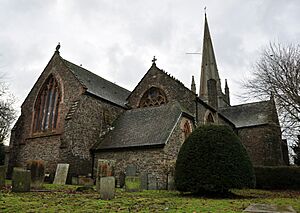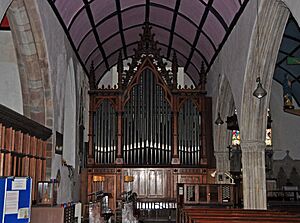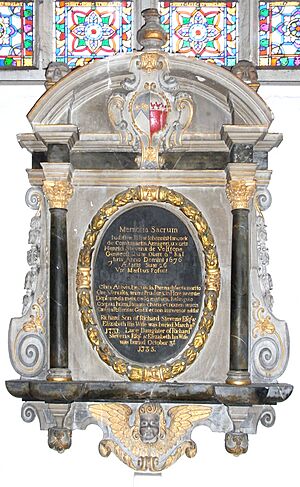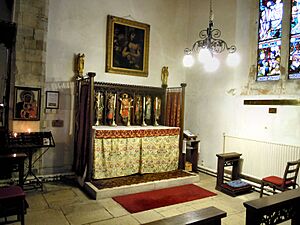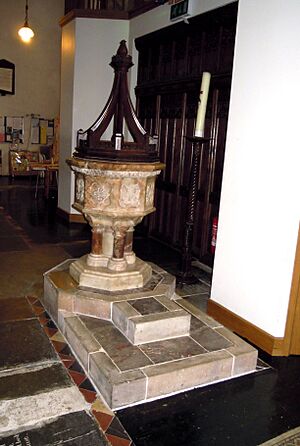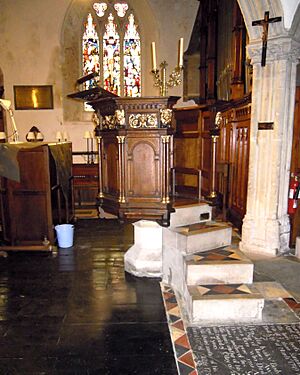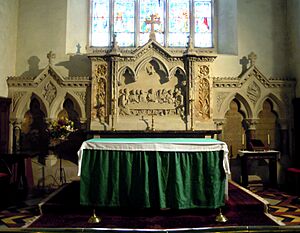St Michael and All Angels, Great Torrington facts for kids
Quick facts for kids Church of St Michael and All Angels |
|
|---|---|
| Church of St Michael | |
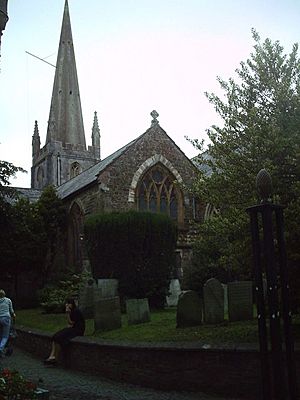
Church and churchyard
|
|
| 50°57′09″N 4°08′38″W / 50.9525°N 4.1439°W | |
| Location | Church Walk, Great Torrington, Devon, EX38 8BN |
| Country | England |
| Denomination | Church of England |
| Previous denomination | Roman Catholic Church |
| Churchmanship | Traditional Catholic |
| History | |
| Status | Active |
| Dedication | St Michael and All Angels |
| Architecture | |
| Functional status | Parish church |
| Heritage designation | Grade II* |
| Designated | 19 March 1951 |
| Administration | |
| Parish | Great Torrington |
| Deanery | Torrington |
| Archdeaconry | Archdeaconry of Barnstaple |
| Diocese | Diocese of Exeter |
The Church of St Michael and All Angels is a special Church of England church in Great Torrington, Devon. It's known as a parish church, which means it serves the local community. Since 1951, it has been a Grade II* listed building. This means it's a very important historical building.
The church follows a traditional Catholic style within the Church of England. It is part of a group called Forward in Faith. It also gets special guidance from the Bishop of Oswestry.
Contents
Church History
The first time we hear about a church in Torrington was in 1259. That's when a vicar was chosen to lead it. But there was probably a church here even earlier. Some parts of the building we see today are from the 13th or 14th century.
The 1646 Explosion
In February 1646, something dramatic happened. The bell tower of the church was blown up during the Battle of Torrington. This battle was part of the First English Civil War. Soldiers called Royalists had stored about 80 barrels of gunpowder inside the church.
When the Parliamentarians captured the town, they put their prisoners in the church. Somehow, the gunpowder exploded. This caused a huge blast and many lives were lost. The explosion likely came from the south side of the church. It destroyed several pillars and a fire then burned old furniture and monuments. The church had to be rebuilt, and this was finished in 1651.
Church Design and Features
The church has a beautiful wagon roof, which is common in this part of England. The window designs, called tracery, are from around 1861. They were designed by William White. The current tower and its pointed top, called a spire, were finished in 1828.
Church Bells
The tower has a set of eight bells. Five of them were made in 1716 by Abraham Rudhall of Gloucester. They were rehung in 1884. Three newer bells were made in 1934 by John Taylor & Co of Loughborough. There's also an old clock bell from 1632. It survived the 1646 explosion and is now in the spire.
Inside the Church
The baptismal font is where baptisms take place. It's made of red marble, has eight sides, and was created in 1914. Near the font, in an oak cabinet, is a wax copy of the Great Seal of England. This seal was used by King James I. It was probably once attached to an important document given to the town.
The church's war memorial includes pieces of glass saved from Westminster Chapter House. These pieces were salvaged after bomb damage during World War II. Around the church, you can see a lovely set of the Stations of the Cross. These pictures show events from the last day of Jesus's life.
Monuments and Organ
On the north wall, there are two monuments. One is for Mrs Penelope Johnson and the other for Mrs Palmer. Both were relatives of the famous painter Sir Joshua Reynolds. He often visited them and once brought the writer Dr Samuel Johnson with him.
The Willis Organ is one of the best in the West Country. It's like a twin to the organ in Truro Cathedral. The pulpit, where sermons are given, has carved angels and gold decorations. It's a typical design from the 1600s. During a church update in the 1860s, the pulpit was moved. Its matching top, called a sounding board, was thrown out. Luckily, it was saved and given to the Victoria and Albert Museum in London. In 1960, it was returned to the church on loan.
Art and Sculptures
The Crucifix (a cross with Jesus on it) behind the pulpit was carved in 1934. It was made in Oberammergau by Willy Bierling. He played St John the Evangelist in the famous Oberammergau Passion Play that year.
A large cross hanging in the arch of the chancel (the area near the altar) was added in 2002. It used to be in St Oswald's Church, Small Heath in Birmingham. It was given there as a war memorial. The stone and marble reredos (a screen behind the altar) was made in 1878. It has a carving of the Last Supper by sculptor Harry Hems.
To the right of the altar steps is a wooden figure of the Virgin Mary. It was carved by French nuns. A bronze figure of St Michael is to the right of the chancel steps. This was made by Mother Concordia from St Mildred's Abbey in Thanet. At the east end of the south aisle, there's a small Tudor room. This room survived the 1646 explosion. It's now used as the vestry, where clergy prepare for services. It might have been a library long ago.
Chapel of St James
The Chapel of St James is in the South Transept. It's named after a chapel that used to be at Torrington Castle. This chapel was set up to remember Frank Emlyn Jones. He was the Vicar from 1894 to 1934 and later an Archdeacon. This is also where the original church tower stood before it was rebuilt in the early 1800s.
The altar in the chapel is from the 1600s. The figures on the reredos behind the altar represent different saints and places. They include St Michael, St Giles, St Mary the Virgin, St James, St Mary Magdalene, and St Gabriel.
Above the altar is an oil painting. It's a copy of 'Ecce Homo' by the artist Caravaggio. To the left of the altar is an icon (a religious painting) of Our Lady of Częstochowa. The original icon is in Poland. This icon is here because of a special court case in 1984. The church won the right to display it.
The window in the chapel remembers Thomas Fowler. He was an apothecary (like a pharmacist) and an inventor. The window shows two of his inventions: the thermosiphon, which helped create central heating systems, and a calculating machine. This machine was an early version of a computer and was admired by Charles Babbage.
Church Exterior
Some people who died in the 1646 explosion are buried in a mass grave. It's under the cobbled area opposite the main entrance. A stone remembering the disaster is to the right of the entrance. The current tower and spire were built in 1828. The old tower was taken down around that time.
The tower was designed by W.B. Cock, a local builder. He also designed the nearby Pannier Market. His initials are in the path outside the South West door. The carved stone heads by the West door are from the 1800s. They show Cardinal Thomas Wolsey and Lady Margaret Beaufort. She was the mother of King Henry VII. The churchyard has not been used for burials since 1850.
Notable People Connected to the Church
- Thomas Wolsey: A powerful figure in Tudor times. He was an Archbishop and a Cardinal. He used to be the rector of this church.
- Hugh Peter: A preacher and advisor who supported the Parliament during the English Civil War.
- William Keble Martin: He wrote a famous book called Concise British Flora in Colour. He served as vicar from 1934 to 1943.


